Do you have a question about the La Crosse Technology WT-5120 and is the answer not in the manual?
Lists the primary functionalities and capabilities of the projection alarm clock.
Description of the temperature transmitter's role and operation.
Details on connecting and using the AC/DC adapter for continuous power.
Steps for powering the clock and transmitter and establishing initial communication.
Instructions to reset the clock to factory defaults or after malfunctions.
Guidance on annual battery replacement for optimal unit accuracy.
How the projection works based on power source (AC/battery).
Information on auto-focus, viewing distance, and rotating the projected display.
How to cycle through temperature, seconds, alarm time, and date displays.
Explanation of the DCF-77 atomic clock signal, its source, and transmission range.
Understanding the DCF tower icon as an indicator of signal reception status.
Steps to take if the DCF time signal is not received correctly.
Functions of the SNOOZE key, including snooze, brightness, and exiting settings.
Functions of the AL/HR key, for alarm setting, activation, and time adjustments.
Functions of the MODE/MIN key for settings, time/date adjustments, and display toggling.
Controls for adjusting projection brightness and direction, and activating backlight.
Procedure for manually setting the time zone offset from UTC.
How to manually set the time when DCF signal reception fails.
Manually updating the date (day, month, year) if radio signals are not received.
Selecting between 12-hour and 24-hour time display formats.
Choosing the preferred unit for temperature display (Celsius or Fahrenheit).
Procedure for setting the desired alarm time for the clock.
How to enable or disable the alarm function and its indicator.
Instructions for using the snooze function and silencing the alarm.
Understanding the low battery warning on the LCD display.
Troubleshooting steps if outdoor temperature data is not received by the projection clock.
Factors affecting 868MHz transmission range and potential sources of interference.
Instructions for wall mounting or placing the outdoor temperature transmitter.
Advice on checking reception before permanently fixing the transmitter location.
Guidelines for handling the device, batteries, and LCD display to prevent damage.
Indoor and outdoor temperature measurement ranges and resolutions.
Details on transmission range and data checking intervals for temperature.
Information on power usage and expected battery life for the units.
Physical dimensions of the projection alarm clock and outdoor transmitter.
Guidelines for responsible disposal of electronic waste and user obligations.
Disclaimers on product use, accuracy, medical use, and warranty.
Lists the primary functionalities and capabilities of the projection alarm clock.
Description of the temperature transmitter's role and operation.
Details on connecting and using the AC/DC adapter for continuous power.
Steps for powering the clock and transmitter and establishing initial communication.
Instructions to reset the clock to factory defaults or after malfunctions.
Guidance on annual battery replacement for optimal unit accuracy.
How the projection works based on power source (AC/battery).
Information on auto-focus, viewing distance, and rotating the projected display.
How to cycle through temperature, seconds, alarm time, and date displays.
Explanation of the DCF-77 atomic clock signal, its source, and transmission range.
Understanding the DCF tower icon as an indicator of signal reception status.
Steps to take if the DCF time signal is not received correctly.
Functions of the SNOOZE key, including snooze, brightness, and exiting settings.
Functions of the AL/HR key, for alarm setting, activation, and time adjustments.
Functions of the MODE/MIN key for settings, time/date adjustments, and display toggling.
Controls for adjusting projection brightness and direction, and activating backlight.
Procedure for manually setting the time zone offset from UTC.
How to manually set the time when DCF signal reception fails.
Manually updating the date (day, month, year) if radio signals are not received.
Selecting between 12-hour and 24-hour time display formats.
Choosing the preferred unit for temperature display (Celsius or Fahrenheit).
Procedure for setting the desired alarm time for the clock.
How to enable or disable the alarm function and its indicator.
Instructions for using the snooze function and silencing the alarm.
Understanding the low battery warning on the LCD display.
Troubleshooting steps if outdoor temperature data is not received by the projection clock.
Factors affecting 868MHz transmission range and potential sources of interference.
Instructions for wall mounting or placing the outdoor temperature transmitter.
Advice on checking reception before permanently fixing the transmitter location.
Guidelines for handling the device, batteries, and LCD display to prevent damage.
Indoor and outdoor temperature measurement ranges and resolutions.
Details on transmission range and data checking intervals for temperature.
Information on power usage and expected battery life for the units.
Physical dimensions of the projection alarm clock and outdoor transmitter.
Guidelines for responsible disposal of electronic waste and user obligations.
Disclaimers on product use, accuracy, medical use, and warranty.
| Brand | La Crosse Technology |
|---|---|
| Model | WT-5120 |
| Category | Alarm Clock |
| Language | English |

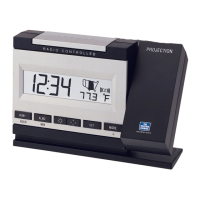
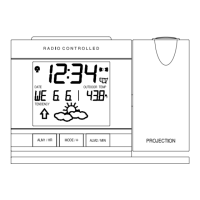
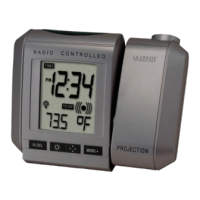
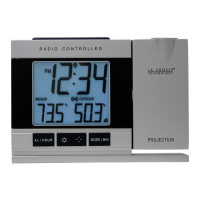
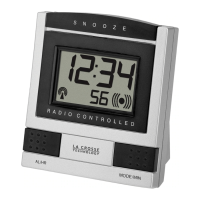

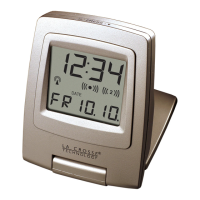
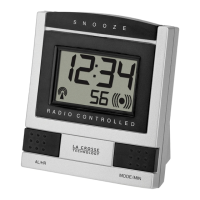
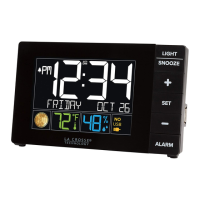
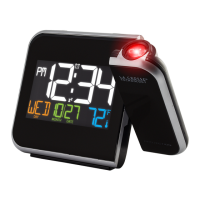
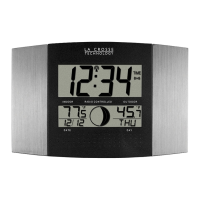
